Middle age, the Era of war in mobile combat and a siege battle had Feudal armies marching with knights on a battlefield.
Weapons became the essential factors to be able to be present on the battlefield. For that, a new series of weapons started to emerge.
The emerged weapons made the armies stronger and more tactical. Baton, Crossbow, Halberd, and Mace were major weapons used by the cavalry and the infantry.
Here is the list of the top 10 weapons used on the battlefield in the Medieval Era.
10. Swords
Content
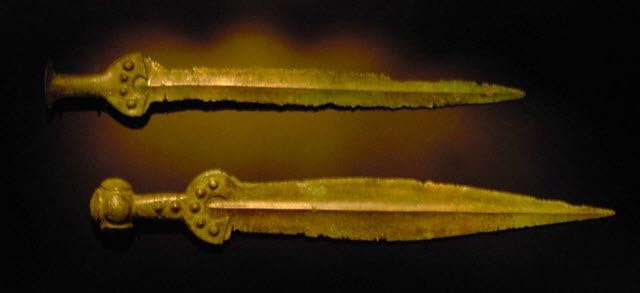
Source: Wikimedia Common
Swords have a long history since the bronze age. They were first discovered in 3300 BC at Arslantepe, Turkey. Initially, the swords were made using arsenical bronze and were the developed version of the dagger.
They did not have a crossguard in their early days and were short, measuring about 60 cm. During that period, the blades used in all weapons were not longer than 60 cm as the longer blades made with bronze would tend to bend.
However, the swords relatively started to take robust, innovative engineering from 1300 to 1500 BC. The major transition was the extension in a grip allowing a two-handed grip.
The blade began becoming narrow and sharper towards the point around the 13th Century. The reason behind changing the shape of the blade was due to the toughness of the armor, where the older version of the sword with the feature of slashing was not appropriate.
The side-sword was common during the Renaissance period in Europe. In the east, Japan was renowned for its swords during the 13th Century. The warrior-nobility Samurai used various swords Wakizashi, katana, ōdachi, tach, chokutō and tsurugi, (straight one-edged blade)
The sword was used mainly by the elites and ordinary soldiers. However, the size of the blades they used differed.
9. Mace

Source: Wikimedia Common
The existence of Mace can be found in the Upper Paleolithic era. It was a blunt-headed weapon that had a vast and heavy circular head. The head, made with stone, steel, wood, and bronze, was connected to the long handle, usually made of wood, steel, or bronze.
The Knights cavalry used this weapon. However, a unique Mace made with silver and gold was used for ceremonial purposes.
The popularity of Mace began from the time it was used and was considered the favorite weapon of Prince Marko, a Serbian King. Following that, it started being used by numerous cavalry of Russia, Poland, and Ukraine.
Likewise, Mace was one of the most popular weapons in Pre- Columbian America, the Incan Empire, Moche state, and in Ancient India. In Moche state, people made Mace using bone, copperhead, and wood.
8. Crossbow
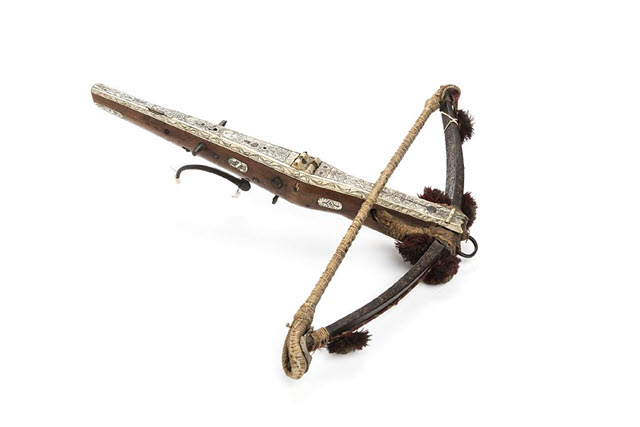
Source: Wikimedia Common
The Crossbow, an essential weapon of the medieval period, consisted of a short bow fixed transversely on a stock. It was used to shoot projectiles known as bolts or quarrels.
The bow was made of steel, wood, or iron, and the string was made of hemp, sinew, or whipcord. Unlike archery and projection, the Crossbow did not require articulated training to use it. The weapon was popular amongst the infantry, and the person using it was known as a crossbowman or an arbalist.
The earliest Crossbow was invented in China in 650 BC. It was used in Ancient China, Greece, Rome, Southeast Asia. This missile weapon was one of the famous Ancient Roman weapons used in almost every Roman battle.
7. Halberd
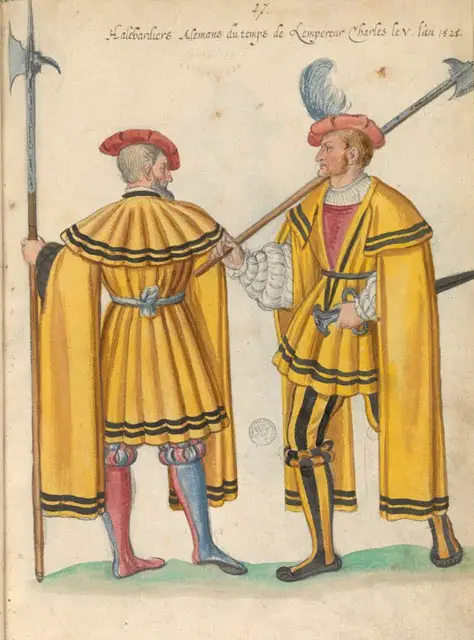
Source: Wikimedia Common
The Halberd was mainly used during the 14th, 15th, and 16th Centuries. And, the army or the troops that used Halberd as their primary weapon were known as the halberdiers.
The word “ Halberd” meant the same as the German words Hellebarde, which was derived from Helmbarte: Halm meaning handle and Barte meaning battleax.
It was a two-hand pole weapon made up of an ax blade topped with a spike mounted on a long shaft. The backside of the ax blade had a hook or a thorn for grappling the mounted combatants.
Most cavalry and troops used this weapon since it was inexpensive to produce and could be used in numerous ways. The point of it was used to push back the horsemen, and the hook on the back could pull the horsemen to the ground.
6. Spear
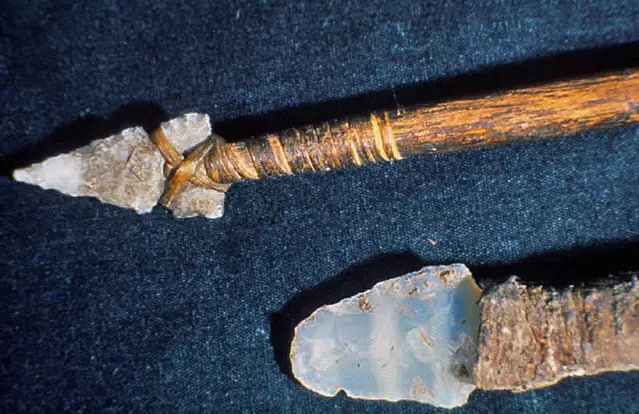
Source: Wikimedia Common
The spear was a popular weapon of the middle age made up of a long shaft of wood and a pointed head. The tapered head was made using bone, bronze, steel, iron, flint, or sometimes even by sharpening the end of the wooden shaft.
Initially, it was designed for hunting during the stone age. Ancient Romans and Greeks modified it and began using it in their battle tactics.
The spear went through a transformation after the fall of the Roman Empire. It was made economical by replacing the iron with shield wood and usable for both the cavalry and infantry.
Though with different names, the weapon is still used by many as a hunting and fishing tool. For instance, the spear is known as Sibat in the Philippines.
5. Longbow

Source: Wikimedia Common
The longbow, also known as a tall bow, was the chief armor of the English army from the 14th Century. It was used in various battles, including the Battle of Sluys 1340 and Poitiers in 1356.
However, the earliest longbow was found around 3300 BC, about the height of 1.8, and made using a yew.
This weapon was used mainly for destructive purposes and was almost the height of the user. The 6 feet height of the bow helped the archer draw long and hit the target from a distance.
The longbow making was relatively simple and less time-consuming since it was made using a single piece of wood. The piece of wood was crafted, making the limbs narrow and circular.
4. Battle axe
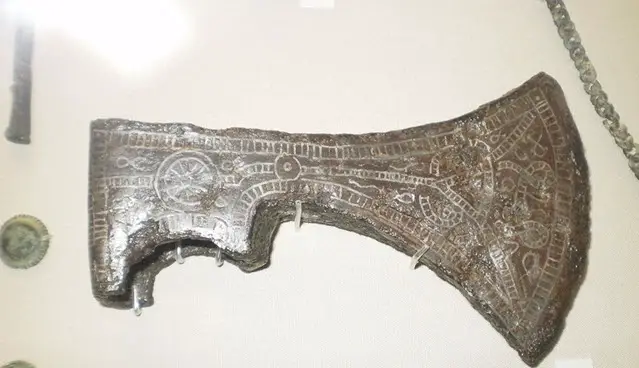
Source: Wikimedia Common
A battle axe was an improved version of an axe used for the battlefield. It was mainly designed for combat, and the cavalry preferred using the battle axe since it was light and easy to carry.
This weapon was first used in the stone age and was made solely from stone. However, during the middle period, the holding portion was made with wood, iron, and steel.
Most of the battle-axes were suitable to be used by one hand, but a few were large enough to be deployed using both hands.
This weapon was commonly used in Europe during the migration period and eventually in the Viking era. King Stephen of England used a Dane Axe in the battle of Lincoln in the 11th Century.
Since then, the weapon has been used in numerous battles, such as Poitiers(1356) and Otterburn(1388).
3. Caltrops

Source: Wikimedia Common
Also known as galtrop, cheval trap, jack rock, and crow’s foot, Caltrop was a defensive weapon. The word ‘Caltrop’ was derived from Calcatrippe, an Old English word, meaning heel-trap.
It was made using two or more spikes where one of the spikes always faced upwards from a stable base.
It was used to slow down the advancement of the horses, chariots, camels, and war elephants as it stuck to the ground with one spike pointing upward. The spike penetrated the feet and imbalanced and trapped the heel.
However, the Caltrop was used by numerous empires and eras with different names. For instance, the ancient Romans called it Tribulus or mures ferrus, and the ancient Greeks called it ‘tribolos.’
2. Baton
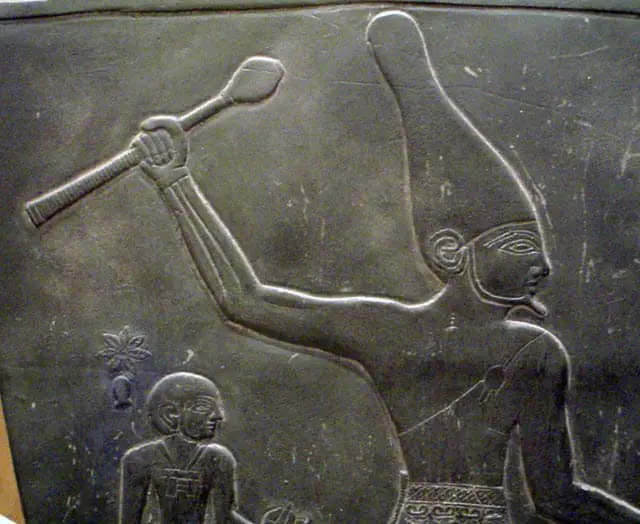
Source: Wikimedia Common
Initially, Baton was not a weapon for war but civilians, security guards, and law enforcement officers. However, the significance of this weapon made the soldiers use it during war training and combat fighting.
The weapon, made up of cylindrical wood with a length of 0.5 meters, was primarily used by one hand to hit an opponent. It was perfect for protecting the foot soldiers from the expected injury. The feudal soldiers during the Middle age used it as throwing weapons due to its lightweight.
Now, the baton is the symbol of various Police and security guards around the world.
1. Gunpowder
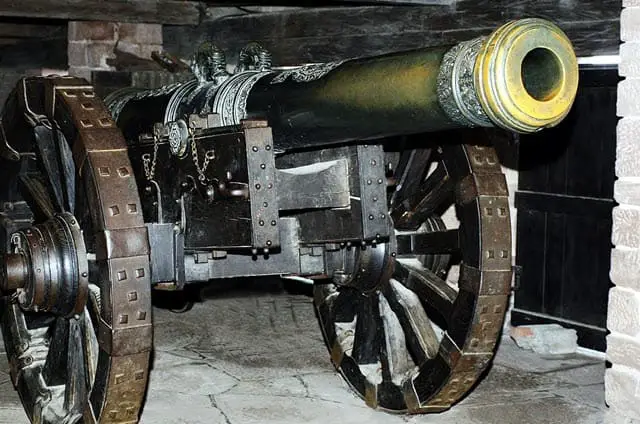
Source: Wikimedia Common
Gunpowder, also known as black powder, was invented in the 9th Century in China. It was the earliest discovered chemical explosive that gained popularity in most parts of Asia and Europe by the end of the 13th Century.
Initially, it was only used as fuel in artillery, rockets, blasting powder, and firearms.
However, the excessive use of gunpowder as a weapon started around the late 15th Century. The new army Musket and the development of firearms(Fint)in the 17th Century completely changed the use of Gunpowder.
Gunpowder in a gun started in the 13th Century with the weapon known as Matchlock. Matchlock, the first mechanism invented for facilitating firing with hand-held firearms, was introduced to China by the Portuguese.
Conclusion
The popularity of a weapon depends on numerous factors, the main being its effectiveness and its cost. The weapons invented during the middle age included both elements and more.
The weapons mentioned above were effective, inexpensive, easy to handle, and inspiring to the upcoming Era. Most of these weapons are still in use, though with different names and a few added features.
